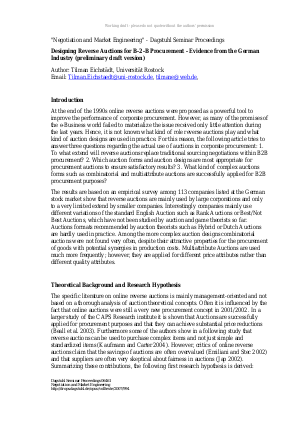Designing Reverse Auctions for B-2-B Procurement – Evidence from the German Industry
Author Tilman Eichstädt
-
Part of:
Volume:
Dagstuhl Seminar Proceedings, Volume 6461
Part of: Series: Dagstuhl Seminar Proceedings (DagSemProc) - License:
 Creative Commons Attribution 4.0 International license
Creative Commons Attribution 4.0 International license
- Publication Date: 2007-05-15
File

PDF
DagSemProc.06461.8.pdf
- Filesize: 69 kB
- 9 pages
Document Identifiers
Subject Classification
Keywords
- Auctions
- auction design
- procurement
- hybrid auctions
- framing effects,
Metrics
- Access Statistics
-
Total Accesses (updated on a weekly basis)
0Document
0Metadata
Abstract
For a long time on-line reverse auctions have been proposed as an effective tool to improve the performance of corporate procurement. Five years after the end of the Internet and e-business hype, reverse auctions have become a standard procurement tool for large corporations. However, it has not been assessed as yet to what extent users actively apply the findings of auction theory to improve the design of reverse auctions. Based on a representative survey of companies using procurement auctions in Germany, the following paper reveals which auction designs are used in practice and to what extent more complex and sophisticated auction designs are adopted. By comparing the empirical results with the concepts of auction theory it is shown which levers can be pulled to improve the design of an auction. For auctions with many bidders, hybrid auctions seem to be promising as they can reasonably combine the benefits of different standard auction models. For auctions with only a few bidders, Dutch auctions might be superior to English auctions as they can create additional uncertainty and induce risk-averse bidders to bid more aggressively. In practice, however, it is very common that companies use different variations of the English auction such as rank or best/not best auctions rather than Dutch or hybrid auctions. Here it seems that framing effects rather than game-theoretic factors play an important role.
Cite As Get BibTex
Tilman Eichstädt. Designing Reverse Auctions for B-2-B Procurement – Evidence from the German Industry. In Negotiation and Market Engineering. Dagstuhl Seminar Proceedings, Volume 6461, pp. 1-9, Schloss Dagstuhl – Leibniz-Zentrum für Informatik (2007)
https://doi.org/10.4230/DagSemProc.06461.8
BibTex
@InProceedings{eichstadt:DagSemProc.06461.8,
author = {Eichst\"{a}dt, Tilman},
title = {{Designing Reverse Auctions for B-2-B Procurement – Evidence from the German Industry}},
booktitle = {Negotiation and Market Engineering},
pages = {1--9},
series = {Dagstuhl Seminar Proceedings (DagSemProc)},
ISSN = {1862-4405},
year = {2007},
volume = {6461},
editor = {Nick Jennings and Gregory Kersten and Axel Ockenfels and Christof Weinhardt},
publisher = {Schloss Dagstuhl -- Leibniz-Zentrum f{\"u}r Informatik},
address = {Dagstuhl, Germany},
URL = {https://drops.dagstuhl.de/entities/document/10.4230/DagSemProc.06461.8},
URN = {urn:nbn:de:0030-drops-9944},
doi = {10.4230/DagSemProc.06461.8},
annote = {Keywords: Auctions, auction design, procurement, hybrid auctions, framing effects,}
}
